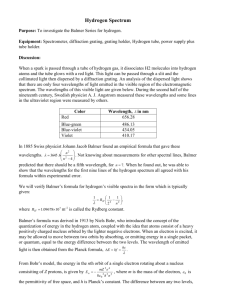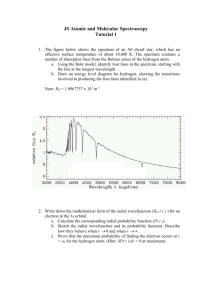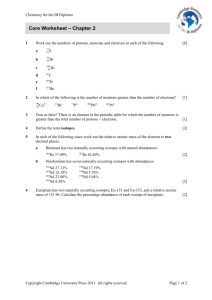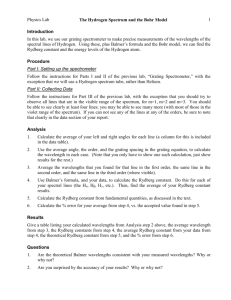24: Lab. 24 Hydrogen atomic spectrum and Planck’s... I. Object
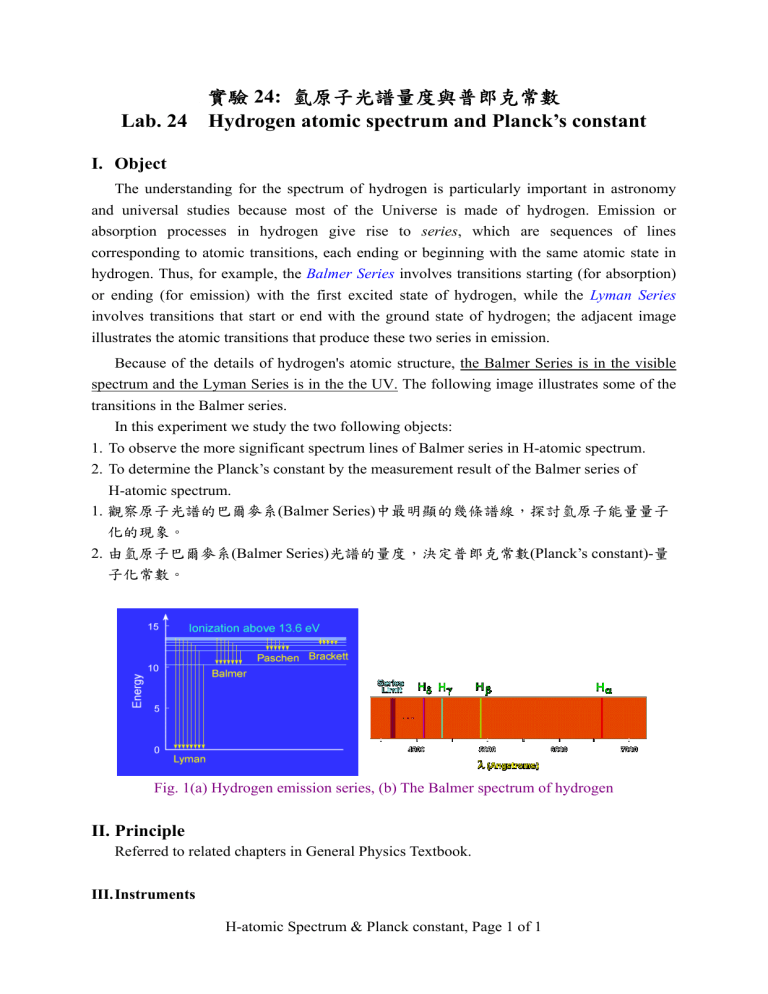
實驗 24: 氫原子光譜量度與普郎克常數
Lab. 24 Hydrogen atomic spectrum and Planck’s constant
I.
Object
The understanding for the spectrum of hydrogen is particularly important in astronomy and universal studies because most of the Universe is made of hydrogen. Emission or absorption processes in hydrogen give rise to series , which are sequences of lines corresponding to atomic transitions, each ending or beginning with the same atomic state in hydrogen. Thus, for example, the Balmer Series involves transitions starting (for absorption) or ending (for emission) with the first excited state of hydrogen, while the Lyman Series involves transitions that start or end with the ground state of hydrogen; the adjacent image illustrates the atomic transitions that produce these two series in emission.
Because of the details of hydrogen's atomic structure, the Balmer Series is in the visible spectrum and the Lyman Series is in the the UV. The following image illustrates some of the transitions in the Balmer series.
In this experiment we study the two following objects:
1.
To observe the more significant spectrum lines of Balmer series in H-atomic spectrum.
2.
To determine the Planck’s constant by the measurement result of the Balmer series of
H-atomic spectrum.
1.
觀察原子光譜的巴爾麥系 (Balmer Series) 中最明顯的幾條譜線,探討氫原子能量量子
化的現象。
2.
由氫原子巴爾麥系 (Balmer Series) 光譜的量度,決定普郎克常數 (Planck’s constant)量
子化常數。
Fig. 1(a) Hydrogen emission series, (b) The Balmer spectrum of hydrogen
II.
Principle
Referred to related chapters in General Physics Textbook.
III.
Instruments
H-atomic Spectrum & Planck constant, Page 1 of 1
Spectrometer, gratings, triangular prism, white lamp, gad discharge tube with high-voltage power supply, hydrogen-gas tube (or called hydrogen spectrum tube), and other gas source tube (for example, Hg gas tube).
實驗裝置組裝圖
Configuration of experiment
Fig. 2 Configuration of Spectrometer platform
(a) System block diagram ( 系統方塊圖 ):
①
Light source ( 光源 )
②
Collimating slit ( 準直狹縫 )
③
Grating ( 光柵 )
④
Telescope ( 望眼鏡 )
(b)Real configuration photos ( 實體架設圖 ):
①
Collimating slit ( 準直狹縫 )
②
Width thumbscrew of collimating slit ( 準
直狹縫寬度調整鈕 )
③ T humbscrew
of collimating lens ( 準直透
鏡調整鈕 )
④
Fixing device of triangular prism ( 三稜鏡
固定器 )
⑤
Thumbscrew of ocular ( 目鏡調整鈕 )
⑥
Grating mounting frame ( 光柵固定器 )
Subscribed from Griffin International
Catalogy 84, XFT-700-K, p.406 (year xxxx).
Fig. 2 (a) Simple block diagram, (b) Experimental configuration of Spectrometer.
IV.
Experimental procedures
1.
Assemble the experimental platform including the light source, grating, and spectrometer devices as shown in Fig. 2.
2.
Connect the power cable of high voltage power supply to the hydrogen gas tube, and switch on the power supply. Once the hydrogen gas tube illuminates, the hydrogen spectrum can be obtained. Caution: Do not touch the electrodes and gas tube when the power is supplied.
3.
Adjust the telescope to locate on the front of the slit, it means the telescope is located on the angular position of
θ
= 180 o
.
4.
Adjust the position of the light source so that the incident light emits into the center of the collimating slit. And let the light source is as close as to the slit.
H-atomic Spectrum & Planck constant, Page 2 of 2
5.
Adjust the slit width, collimating lens and the ocular of the telescope so that you can observe a clear image made by the slit in the telescope.
6.
Adjust the grating position so that the grating plane is perpendicular to the collimating tube.
7.
Rotate the telescope to find the Balmer series spectrum as shown in Fig. 3(a). Due to the intensity limitation of the light, you can only observe 3 spectrum lines of H α , H β , and H γ in the first series and only 1 line of H β is observed in the second series spectrum as shown in
Fig. 3(b).
(a)
(b)
Fig. 3 (a) The emission spectrum of hydrogen atom; (b) The energy level diagram of hydrogen atom: 1 Lymann series ( 萊曼譜線系 ), 2 Balmer series ( 巴爾麥譜線系 ), 3
Paschen series ( 帕申譜線系 ), 4 Brackett series ( 布拉開譜線系 ), 5 Pfund series ( 普芬德譜
線系).
H-atomic Spectrum & Planck constant, Page 3 of 3
8.
Measure accurately the angles
θ
from the incident line to the first-order spectral lines of the Balmer series. The accuracy of the measured angles shall be lower than 1/60 o
[Note].
The measuring method of angle on the spectrometer is similar to that of the vernier scale.
Note: The minimum scale of the primary scale is 0.5
o
. Because the 15 scales in the secondary scale are equal to 14.5
o
in the primary scale, it is correspondence with 29/60 degree each scale in the secondary scale. So the accuracy of the angle measurement can be read off up to 1/60 o
.
9.
Measure the angles between the second order spectral lines of Balmer series and the incident light.
10.
Repeat the above measuring procedures (8 th
and 9 th
procedures) at least twice from the front, the left- and the right-sides of the slit, respectively. You must recheck the scale of the spectrometer every time when the telescope is re-moved back to the front of the slit.
11.
Calculate the wavelengths of the Balmer-series spectral lines according to the measured angles and compare your results with the data shown in Fig. 3(b).
12.
Using the following formula and all calculated wavelengths of the spectral lines to determine the Rydbery constant R
H
as well as the average deviation, standard deviation, and the standard error in the mean (SEM, 平均標準誤差 ) of the R
H
value.
1
λ
=
8
ε me
4
0
2 h
3 c
⎛
⎜⎜
1 n
2
2
−
1 n
1
2
⎞
⎟⎟
=
R
H
⎛
⎜⎜
1 n
2
2
−
1 n
1
2
⎞
⎟⎟
R
H
≡
8
ε me
4
0
2 h
3 c
= Rydberg constant h
=
⎛
⎜⎜ me
4
8
ε
0
2 cR
H
⎞
⎟⎟
1 / 3
= Planck’s constant
13.
Then calculate the Planck constant and its various deviations by the obtained R
H
value above.
14.
If other gas spectral tubes which can emit visible light spectrum are available, then repeat all above experiments.
15.
Replace the hydrogen spectral tube by a white light lamp. Observe the spectrum that the white light travels through the grating and the spectrum of the refracted light of the white light which is refracted through the triangular prism. Compare with the both spectra and explain the difference.
V.
Questions
1.
How do you confirm that the observed spectrum in this experiment is the hydrogen atomic spectrum, but not the hydrogen molecular one?
H-atomic Spectrum & Planck constant, Page 4 of 4
2.
Which experiment result of the first- and the second-series spectra is better? Please describe your reasons.
3.
How do you correct the experiment results if the grating were not well perpendicular to the collimating tube during the sixth procedure,
4.
Why do you observe the H β spectral line in the second series spectrum only?
VI.
References
1.
D. Halliday & R. Resnick: “Fundamentals of Physics”, 8 th
ed., extended version (John
Wiley & Sons Inc., New York, 2007), Section 39-8 & 39-9..
2.
Hyper Physics web site: http://hyperphysics.phy-astr.gsu.edu/hbase/hyde.html#c4 , HyperPhysics
→
Index
→
Quantum Physics
→
Hydrogen concepts
→
Atomic structure concepts
→
Atomic spectra .
3.
Demo 25-01 “Emission Spectra” and Demo 25-02 Spectral Absorption by Na Vapor”, The
Video Encyclopedia of Physics Demonstration, The Education Group ed., 2000.
H-atomic Spectrum & Planck constant, Page 5 of 5

